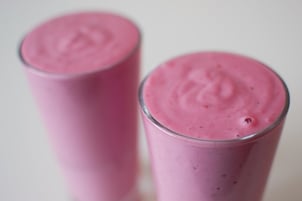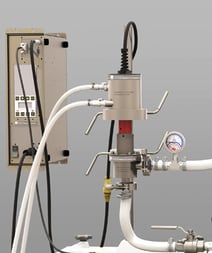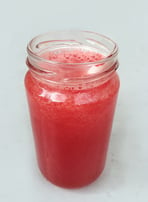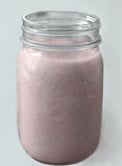 One of the main challenges in the food & beverage industry is the inactivation of microorganisms (pasteurization). Thermal treatment of such products as milk and fruit-based beverages (generally, at over 70 °C) is currently the most commonly applied pasteurization method. Unfortunately, this approach causes significant deterioration of many of these products' attributes, such as flavor, color and nutritional quality. Alternative, non-thermal pasteurization methods that can not only ensure the microbial safety of the products, but also preserve their quality are, therefore, of great interest to this industry.
One of the main challenges in the food & beverage industry is the inactivation of microorganisms (pasteurization). Thermal treatment of such products as milk and fruit-based beverages (generally, at over 70 °C) is currently the most commonly applied pasteurization method. Unfortunately, this approach causes significant deterioration of many of these products' attributes, such as flavor, color and nutritional quality. Alternative, non-thermal pasteurization methods that can not only ensure the microbial safety of the products, but also preserve their quality are, therefore, of great interest to this industry.
In this blog post, we describe our recent ultrasonic pasteurization experiments conducted on freshly prepared water and milk-based fruit smoothies. The description of our earlier experiments on ultrasonic carrot juice pasteurization can be found here.
1. Materials and Methods
 The experiments were conducted using:
The experiments were conducted using:
- ISP-3000 industrial-scale ultrasonic processor configured in the flow-through mode;
- Mixed fruit from a local supermarket;
- Whole milk from a local supermarket;
- Blender;
- Heat exchanger.
The main purpose of these experiments was to test the feasibility of the ultrasonic sterilization method. The optimization of the processing rate and ultrasonic exposure conditions was outside the scope of this study and will be done separately.
2. Water-Based Smoothie Preparation and Ultrasonic Treatment

The ultrasonic processor and all containers were sterilized with bleach and thoroughly washed with sterile deionized water. A fruit mixture was processed into a water-based smoothie using a common blender. The smoothie was then poured into a glass container and pre-heated to 40 °C. The processing conditions were: ultrasonic amplitude --- 100 microns, output power --- 2.6 kW, processing rate --- 1 L/min, temperature --- 40 °C (maintained using the heat exchanger). The "before" and "after" samples were analyzed for Yeast, Mold, Enterobacteriaceae and Aerobic Plate Count. The results are presented below.
Water-based fruit smoothie prior to ultrasonic exposure:
| Test Parameter | Result | Detection Limit | Methods |
| Yeast | 2,420 CFU / mL | 10 CFU / mL | PF-AOAC 997.02 |
| Mold | 10 CFU / mL | 10 CFU / mL | PF-AOAC 997.02 |
| Enterobacteriaceae | 110 CFU / mL | 10 CFU / mL | PF-2003.01 |
| Aerobic Plate Count | 470 CFU / mL | 10 CFU / mL | PP-FDA/BAM Ch.3 |
Water-based fruit smoothie after ultrasonic exposure:
| Test Parameter | Result | Detection Limit | Methods |
| Yeast | <10 CFU / mL | 10 CFU / mL | PF-AOAC 997.02 |
| Mold | <10 CFU / mL | 10 CFU / mL | PF-AOAC 997.02 |
| Enterobacteriaceae | <10 CFU / mL | 10 CFU / mL | PF-2003.01 |
| Aerobic Plate Count | <10 CFU / mL | 10 CFU / mL | PP-FDA/BAM Ch.3 |
3. Millk-Based Smoothie Preparation and Ultrasonic Treatment

The ultrasonic processor and all containers were sterilized with bleach and thoroughly washed with sterile deionized water. A fruit mixture was processed into a milk-based smoothie using a common blender. The smoothie was then poured into a glass container and pre-heated to 40 °C. The processing conditions were: ultrasonic amplitude --- 100 microns, output power --- 2.6 kW, processing rate --- 1 L/min, temperature --- 40 °C (maintained using the heat exchanger). The "before" and "after" samples were analyzed for Yeast, Mold, Enterobacteriaceae and Aerobic Plate Count. The results are presented below.
Milk-based fruit smoothie prior to ultrasonic exposure:
| Test Parameter | Result | Detection Limit | Methods |
| Yeast | 3,680 CFU / mL | 10 CFU / mL | PF-AOAC 997.02 |
| Mold | 150 CFU / mL | 10 CFU / mL | PF-AOAC 997.02 |
| Enterobacteriaceae | 1,770 CFU / mL | 10 CFU / mL | PF-2003.01 |
| Aerobic Plate Count | 340 CFU / mL | 10 CFU / mL | PP-FDA/BAM Ch.3 |
Milk-based fruit smoothie after ultrasonic exposure:
| Test Parameter | Result | Detection Limit | Methods |
| Yeast | <10 CFU / mL | 10 CFU / mL | PF-AOAC 997.02 |
| Mold | <10 CFU / mL | 10 CFU / mL | PF-AOAC 997.02 |
| Enterobacteriaceae | <10 CFU / mL | 10 CFU / mL | PF-2003.01 |
| Aerobic Plate Count | <10 CFU / mL | 10 CFU / mL | PP-FDA/BAM Ch.3 |
4. Conclusions
High-amplitude ultrasound is a simple and effective technique for food and beverage pasteurization, which does not require high temperatures known to deteriorate the quality of the products. With the use of Barbell Horn Ultrasonic Technology (BHUT), the process is directly scalable and can be implemented in an industrial production environment using one or multiple ISP-3000 ultrasonic processors.
.jpg?width=1994&height=332&name=Logo%20Sonomechanics%20White%20No%20Shadow%20R_Final%20(1).jpg)

